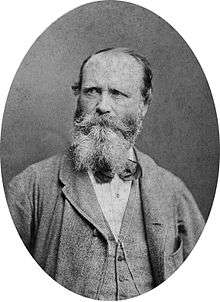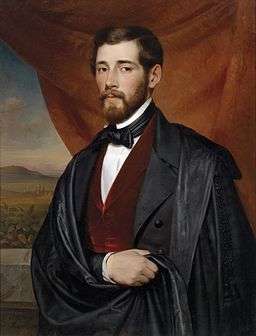Karl von Blaas

Karl von Blaas (28 April 1815 in Nauders – 19 March 1894 in Vienna) was an Austrian painter known for his portraits and religious compositions executed on canvas as well as in the form of frescoes.
Biography
He was born in a peasant family in Nauders, Tyrol. He studied at the Academy of Fine Arts of Venice. In 1837 he received the Pix de Rome from the Venetian Academy, which allowed him to study in Rome. In Rome he came under the influence of the Nazarenes in the circle around Friedrich Overbeck and devoted himself to religious subjects.
He was named a professor at the Academy of Vienna in 1850. In 1855 he received a prize at the Paris Exposition for his painting "Charlemagne Visiting a Boys' School", and accepted a professorship at the Academy of Venice in the same year. He returned to Vienna in 1866 where he wrote Autobiographie, (Vienna, 1876), which contains information on his sons, Eugene de Blaas and Julius von Blaas. He produced many portraits, religious canvases, and frescoes.
Among his pupils was Francesco Beda.
Paintings
- "Jacob's Journey through the Desert" (Museum of Venice)
- "Visitation" (Innsbruck Museum)
- "Charlemagne Visiting a Boys' School" (Venice Museum)
- "Tullia Driving over her Father's Body" (1832)
- "Rape of Venetian Brides in Sixth Century" (1858); Innsbruck Museum)
- "Ekkehard Carrying the Duchess of Suabia across the Threshold of the Monastery"
Works
.jpg) Julius von Blaas by Carl von Blaas
Julius von Blaas by Carl von Blaas Lady walking
Lady walking
 Portrait of a woman
Portrait of a woman Portrait of a man
Portrait of a man
References
-
 This article incorporates text from a publication now in the public domain: Gilman, D. C.; Thurston, H. T.; Colby, F. M., eds. (1905). "article name needed". New International Encyclopedia (1st ed.). New York: Dodd, Mead.
This article incorporates text from a publication now in the public domain: Gilman, D. C.; Thurston, H. T.; Colby, F. M., eds. (1905). "article name needed". New International Encyclopedia (1st ed.). New York: Dodd, Mead.
External links
![]() Media related to Karl von Blaas at Wikimedia Commons
Media related to Karl von Blaas at Wikimedia Commons